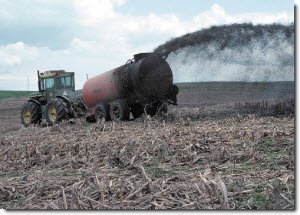Using An Animal For Which Of The Following Would Prevent It From Being Placed In Usda Category B?
The Sources and Solutions: Agriculture

Applying fertilizers in the proper amount, at the right fourth dimension of year and with the correct method can significantly reduce how much fertilizer reaches water bodies.

Keeping animals and their waste matter out of streams keeps nitrogen and phosphorus out of the water and protects stream banks.
Farmers employ nutrients on their fields in the course of chemic fertilizers and animal manure, which provide crops with the nitrogen and phosphorus necessary to grow and produce the food we eat. Still, when nitrogen and phosphorus are not fully utilized by the growing plants, they tin be lost from the farm fields and negatively touch on air and downstream water quality.
This excess nitrogen and phosphorus can be washed from subcontract fields and into waterways during rain events and when snowfall melts, and can also leach through the soil and into groundwater over time. High levels of nitrogen and phosphorus tin cause eutrophication of water bodies. Eutrophication tin can lead to hypoxia ("expressionless zones"), causing fish kills and a decrease in aquatic life. Excess nutrients can cause harmful algal blooms (HABs) in freshwater systems, which not only disrupt wildlife only tin also produce toxins harmful to humans.
Fertilized soils, equally well as livestock operations, are also vulnerable to nutrient losses to the air. Nitrogen tin exist lost from subcontract fields in the form of gaseous, nitrogen-based compounds, like ammonia and nitrogen oxides. Ammonia tin be harmful to aquatic life if large amounts are deposited from the atmosphere to surface waters. Nitrous oxide is a potent greenhouse gas.
At that place are many ways that farmers can reduce nutrient losses from their operations1, including, but not limited to2:
- Adopting Food Management Techniques: Farmers can improve nutrient direction practices past applying nutrients (fertilizer and manure) in the right amount, at the correct time of year, with the right method and with the right placement.3,4
- Using Conservation Drainage Practices: Subsurface tile drainage is an important practice to manage water movement on and through many soils, typically in the Midwest. Drainage h2o tin can carry soluble forms of nitrogen and phosphorus, so strategies are needed to reduce nutrient loads while maintaining adequate drainage for crop production. Conservation drainage describes practices including modifying drainage system pattern and performance, woodchip bioreactors, saturated buffers, and modifications to the drainage ditch system. 5,vi
- Ensuring Yr-Circular Ground Encompass: Farmers can constitute cover cropsseven or perennial species8 to prevent periods of bare ground on farm fields when the soil (and thesoil andnutrients it contains) are well-nigh susceptible to erosion and loss into waterways.
- Planting Field Buffers: Farmers can plant trees, shrubs and grasses forth the edges of fields; this is especially important for a field that borders water bodies. Planted buffers can aid prevent food loss from fields past absorbing or filtering out nutrients before they accomplish a water body.ix
- Implementing Conservation Cultivation: Farmers can reduce how oftentimes and how intensely the fields are tilled. Doing so can help to improve soil health, andreduce erosion, runoff and soil compaction, and therefore the chance of nutrients reaching waterwaysthrough runoff.10
- Managing Livestock Admission to Streams: Farmers and ranchers can install fence forth streams, rivers and lakes to block access from animals to aid restore stream banks and preclude excess nutrients from inbound the water.11
- Engaging in Watershed Efforts: The collaboration of a wide range of people, stakeholders and organizations beyond an entire watershed is vital to reducing nutrient pollution to our water and air. Farmers can play an important leadership role in these efforts when they go involved and engage with their State governments, farm organizations, conservation groups, educational institutions, non-profit organizations, and community groups.
1Reducing Nutrient Loss: Scientific discipline Shows What Works
2 USDA Natural Resources Conservation Service Conservation Practise Standards are the best bachelor baseline nationally for implementation of these practices.
3Pennsylvania Nutrient Management Program
4Best Management Practices for Agronomical Nutrients
5Transforming Drainage
viConservation Drainage for the Midwest
viiComprehend Crops - Keeping Soil in Identify While Providing Other Benefits
8Enquiry shows perennials would reduce nutrient runoff to the Gulf of Mexico's dead zone
nineBuffers and Vegetative Filter Strips
10Conservation tillage
11Stream Bank Fencing: Green Banks, Clean Streams
Source: https://www.epa.gov/nutrientpollution/sources-and-solutions-agriculture
Posted by: higginshavem1951.blogspot.com

0 Response to "Using An Animal For Which Of The Following Would Prevent It From Being Placed In Usda Category B?"
Post a Comment